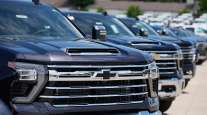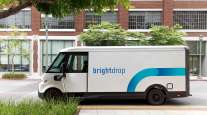GM’s Cruise Unveils New Robotaxi Concept

[Stay on top of transportation news: Get TTNews in your inbox.]
SAN FRANCISCO — General Motors’ self-driving car company will attempt to deliver on its long-running promise to provide a more environmentally friendly ride-hailing service in an unorthodox vehicle designed to eliminate the need for human operators to transport people around crowded cities.
The service still being developed by GM’s Cruise subsidiary will rely on a boxy, electric-powered vehicle called “Origin” that was unveiled late Jan. 21 in San Francisco amid much fanfare. It looks like a cross between a mini-van and sports utility vehicle with one huge exception — it won’t have any steering wheel or brakes. The Origin will accommodate up to four passengers at a time, although a single customer will be able summon it for a ride just as people already can ask for a car with a human behind the wheel from Uber or Lyft.
For all the hype surrounding the Origin’s unveiling, Cruise omitted some key details, including when its ride-hailing service will be available and how many of the vehicles will be in its fleet. The company indicated it will initially only be available in San Francisco, where Cruise has already been offering a ride-hailing service that’s only available to its roughly 1,000 employees.
By eliminating the need for a human to drive, Cruise theoretically will be able to offer a less expensive way to get around — a goal already being pursued by self-driving car pioneer Waymo, a Google spinoff that has been testing robotaxis in the Phoenix area for nearly three years.
Cruise had planned to have a robotaxi service consisting of Chevrolet Bolts working without human backup drivers by the end of 2019, but moved away from that last year after one of Uber’s autonomous test vehicles ran down and killed a pedestrian in the Phoenix suburb of Tempe, Ariz., during 2018.
Still aware of the fallout from that deadly crash, Cruise is promising “superhuman performance” from the Cruise, which GM hopes to manufacture at half the price of comparable vehicles using fuel-combustion engines. GM also expects to announce where the Origin will be made within the next few weeks, Cruise CEO Dan Amman said.
The Origin won’t be sold to consumers. “It is not a product you can buy, but an experience you share,” Amman said.
The Origin represents another significant step for Cruise, which had only 40 employees when GM bought it in 2016 as part of its effort to catch up in the race to build cars that can drive themselves. Since then, Cruise has attracted more than $6 billion from investors, including $2.75 billion from Honda and $2.25 billion from Japanese tech investment firm SoftBank. Honda also helped develop the Origin.
GM currently values Cruise at $19 billion, fueling speculation that the subsidiary may eventually be spun off as a publicly traded company.
Whenever Cruise’s ride-hailing service makes its debut, it will still be chasing Waymo, whose work on self-driving car technology began inside Google more than a decade ago.
Waymo’s Phoenix-area service already has given more than 100,000 rides, according to the company. It expanded beyond the test phase service 13 months ago with a ride-hailing app that now has about 1,500 active monthly riders, Waymo says.
By comparison, ride-hailing leader Uber now boasts about 103 million active monthly users with a service that relies on human drivers — a dependence that is the main reason the company has been losing money throughout its history. Despite the fatal 2018 crash that stoked the public’s worst fears about self-driving cars, Uber is still trying to build a fleet of robotic taxis as part of its quest to become profitable.
Tesla CEO Elon Musk has also pledged that his company’s electric cars will be able to drive themselves without a human behind the wheel before the end of this year so they can moonlight as taxis when their owners don’t need the vehicles, but industry analysts doubt that promise will come to fruition.
Want more news? Listen to today's daily briefing:




